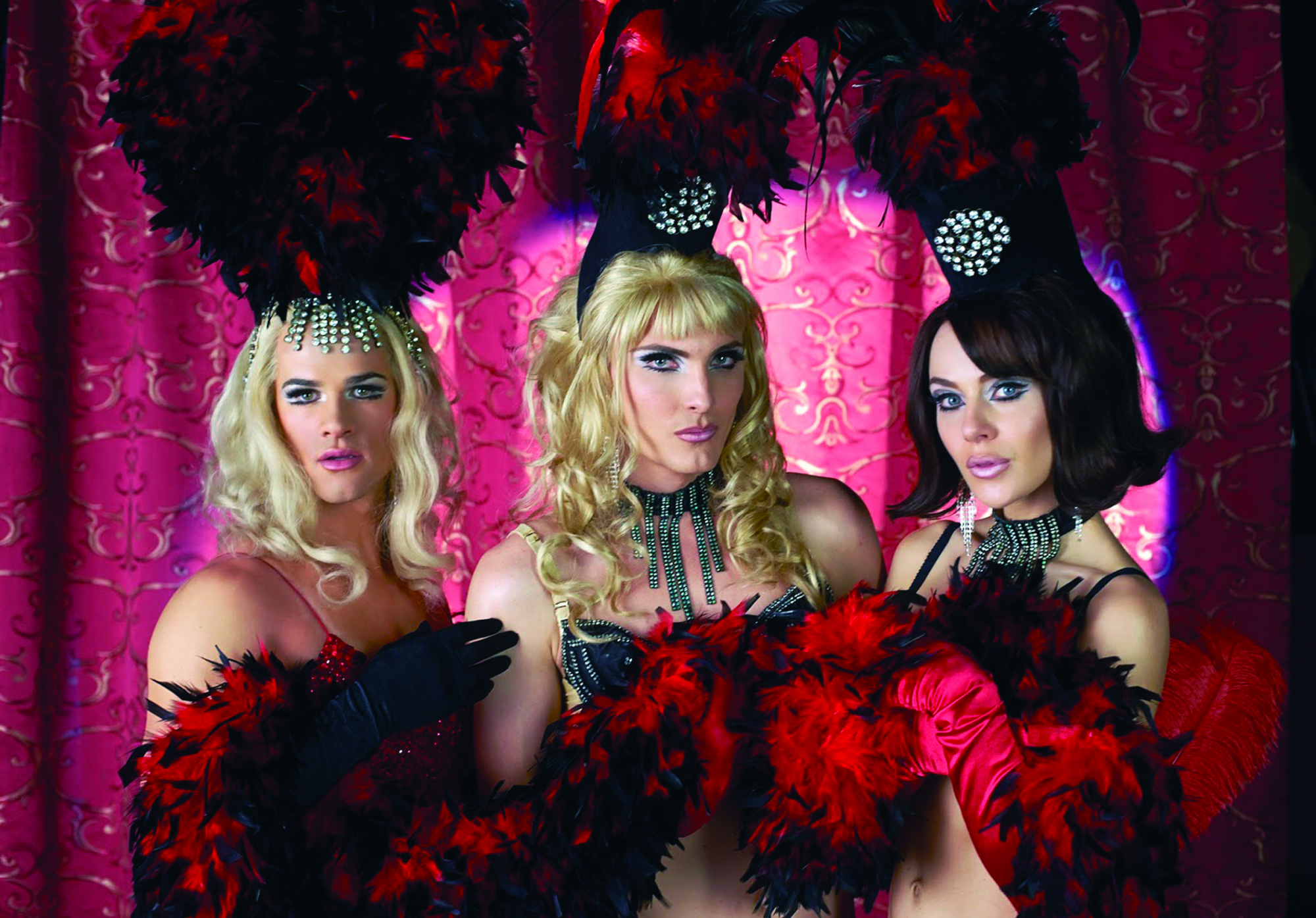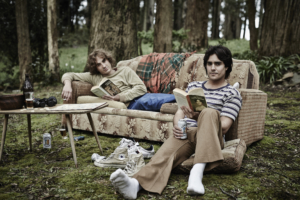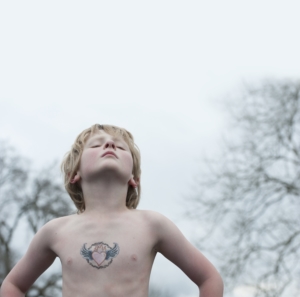This year, Priscilla is turning twenty-one and, like most on the verge of adulthood, she has put on a party frock, has done her hair and is ready to celebrate. But the monumental success of The Adventures of Priscilla, Queen of the Desert (Stephan Elliott, 1994) is being celebrated, not with a tacky birthday party featuring jelly shots and a suspicious bowl of punch, but rather with an all-new ABC documentary that details the extraordinary story of how this radical film was born out of the tragedy of hate, discrimination and deadly silence.
Looking back, it may seem like the success of Priscilla was guaranteed from its inception. Yet, as Between a Frock and a Hard Place (Paul Clarke & Alex Barry, 2015) reveals, Elliott’s film was brought into the world with all of the struggle befitting its persona as an in-your-face queer product. Labelled ‘completely racist’, ‘completely sexist’, ‘completely chauvinistic’ and ‘deeply shallow’, as recounted in the documentary, Priscilla was rejected by every funding body in the country – and even turned down by the Mardi Gras. It was a trouble child from day one. Elliott could be forgiven, then, for not being prepared for the ten-minute standing ovation that greeted him and his crew after the film’s screening in the Un Certain Regard section of the 47th Cannes Film Festival. Or, for that matter, the legacy his film was about to build and, even more impressively, maintain over two decades of rapidly evolving LGBTQIA-rights advances and Australian film-industry peaks and valleys. Priscilla was the highest-grossing Australian film of 1994 and the third-highest-grossing film of the decade.[1]Screen Australia, ‘Top 100 Australian Feature Films of All Time, Ranked by Total Reported Gross Australian Box Office as at February 2015’, <http://www.screenaustralia.gov.au/research/statistics/boxofficeaustraliatop100.aspx>, accessed 20 August 2015. It won AFI and BAFTA awards, as well as Oscars for costume designers Lizzy Gardner and Tim Chappel, whose fashions were culled from discarded drag acts, thongs purchased in bulk and tied together with ‘imitation Chanel gold-linked chain detailing’ and fabric bought from Target using a staff discount.[2]National Film and Sound Archive of Australia, ‘Priscilla: 20 Years Young’, <http://www.nfsa.gov.au/visit-us/exhibitions-presentations/Priscilla-20-years-young/>, accessed 20 August 2015. Just like a brassy, ballsy elder stateswoman of Sydney’s Oxford Street, the film has withstood the test of time.
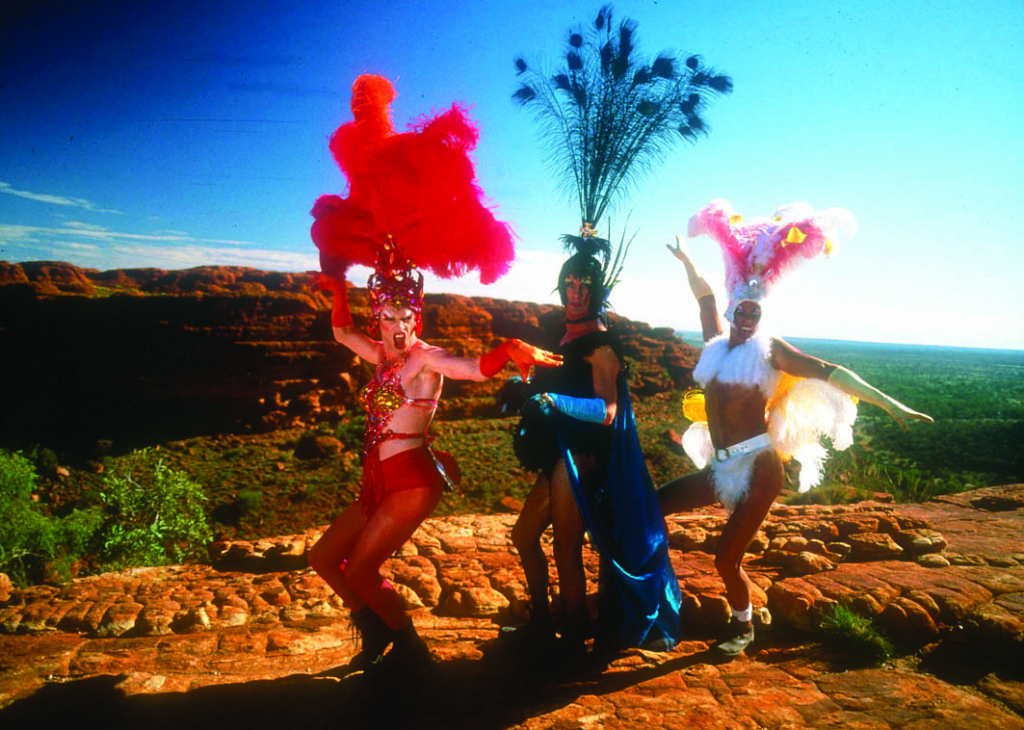
The brash originality of Elliott’s film is still striking for how it reached mainstream audiences like never before or since. For many, Priscilla revealed a new understanding of queer men and women – and the issues they face – by interrupting ‘quintessentially Australian’ tendencies such as self-deprecating humour[3]Luke Buckmaster, ‘The Adventures of Priscilla, Queen of the Desert: Rewatching Classic Australian Films’, The Guardian, 9 May 2014, <http://www.theguardian.com/film/australia-culture-blog/2014/may/09/the-adventures-of-priscilla-queen-of-the-desert-rewatching-classic-australian-films>, accessed 20 August 2015. with poignancy. Such insight is best captured by Terence Stamp’s world-weary Bernadette, who, describing Sydney, observes: ‘We all sit around mindlessly slagging off that vile stink-hole of a city. But, in its own strange way, it takes care of us.’
Then and now: Australian queer film and TV
The year of Priscilla’s release was quite momentous for queer representation in Australia. The Sum of Us (Geoff Burton & Kevin Dowling, 1994) – which tells the story of a supportive dad (Jack Thompson) and his gay son (Russell Crowe) – was released just two months earlier, and was another, albeit smaller, box-office success.[4]Screen Australia, op. cit. Meanwhile, just a week after Priscilla’s Australian debut, a bisexual character (played by Isla Fisher) was introduced on popular night-time soap opera Home and Away. And, while it doesn’t feature any explicitly gay characters, it’s hard to deny the place that Muriel’s Wedding (PJ Hogan, 1994) holds among queer viewers, thanks largely to its overtly camp aesthetic, vulgar jokes, outcast lead character (played by Toni Collette) and devotion to gay icons ABBA.
For many, Priscilla revealed a new understanding of queer men and women – and the issues they face – by interrupting ‘quintessentially Australian’ tendencies such as self-deprecating humour with poignancy.
Also playing the festival circuit that year, before receiving a local release in February 1995, was Only the Brave (Ana Kokkinos, 1994), which was quite unlike its contemporaries by foregrounding not only a queer female voice, but an ethnically diverse one, too. Significantly different from other Australian films with lesbian undertones – such as Picnic at Hanging Rock (Peter Weir, 1975) and The Getting of Wisdom (Bruce Beresford, 1978) – it remains one of the director’s most insightful works. Central to Kokkinos’ film is the representation of Victoria’s working-class western suburbs as a queer wasteland: Only the Brave was the dark and menacing Melbourne-set yin to Priscilla’s candy-coloured Sydney-inspired yang. Kokkinos would tackle these themes once more with Head On (1998). Released in cinemas with an R18+ rating, it signalled the radical changes – both cinematically and politically – that had occurred since 1994, playing like a reaction to the happy-go-lucky perception of modern gay life in Australia. It is bleak and charged with the reckless abandon of youth searching for identity amid a society in which the tradition of heritage and the modernity of sexual openness are in a tug-of-war. Ari (Alex Dimitriades), a ‘double minority’ as a gay Greek-Australian,[5]Kevin Thomas, ‘Movies: Collision with Life: Director Looks at What It Means to Be Greek and Australian, Gay and Conflicted’, Los Angeles Times, 2 September 1999, <http://articles.latimes.com/1999/sep/02/entertainment/ca-5854>, accessed 20 August 2015. struggles with his two identities, confused by the mixed messages he receives from family, friends and lovers. He is also confounded by the city around him: a multicultural hub brimming with heightened masculinity in which he doesn’t know where he fits, and from which he sees no escape.[6]Kokkinos adapted Head On from the novel Loaded by Christos Tsiolkas, whose fingerprints would linger further in the Australian queer titles Saturn’s Return (Wenona Byrne, 2001) and Dead Europe (Tony Krawitz, 2012).
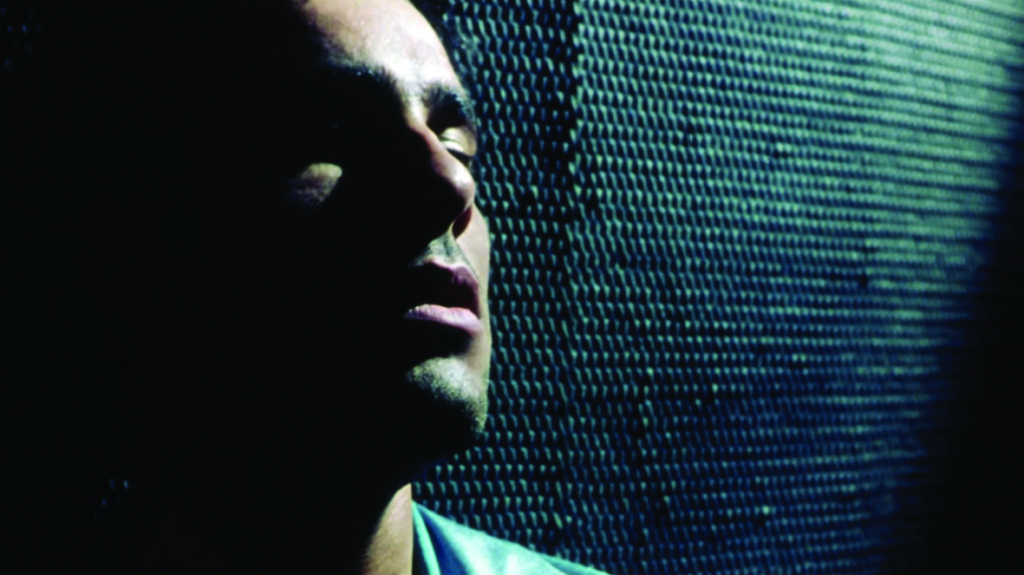
Like Kokkinos, Samantha Lang has created Australian films from a queer-female perspective. With The Well (1997), a tale of sexual repression that spirals into a game of emotional one-upmanship between its older (Pamela Rabe) and younger (Miranda Otto) female protagonists, Lang examines obsession and generational attitudes towards sex. It is one of the most visually striking films from this country, thanks to Mandy Walker’s sumptuously deep-toned cinematography; it’s not at all hard to see why The Well, a debut feature, was able to compete for the prestigious Palme d’Or in that year’s Cannes Film Festival.
In the decade after the year 2000, fiction features with queer themes dropped off substantially … One might have expected Australian filmmakers to more accurately represent queer culture in light of changes in societal attitudes towards the LGBTQIA community.
Lang’s strong focus on queer identity is clearly evident throughout the rest of her career, although The Monkey’s Mask (2000), an adaptation of Dorothy Porter’s verse novel of the same name, is a disappointing erotic thriller that falls prey to the assumption that the gender and sexuality flips of its lead characters are interesting enough to compensate for flat visuals and bad dialogue. A much stronger example of Lang’s work is Carlotta, a 2014 made-for-TV biopic about the eponymous Les Girls dancer (believed to have been the inspiration for Priscilla’s Bernadette[7]James Waites, ‘An Elegant Charm Was Her Best Material’, The Sydney Morning Herald, 22 August 2011, <http://www.smh.com.au/comment/obituaries/an-elegant-charm-was-her-best-material-20110821-1j4li.html>, accessed 20 August 2015.). David Hannam’s screenplay may not do anything with the transgender pioneer’s life that isn’t in the standard biopic playbook, and a cisgender actor, Jessica Marais, may have been cast as Carlotta both before and after transition, but the telemovie does manage to hit the right dramatic notes.
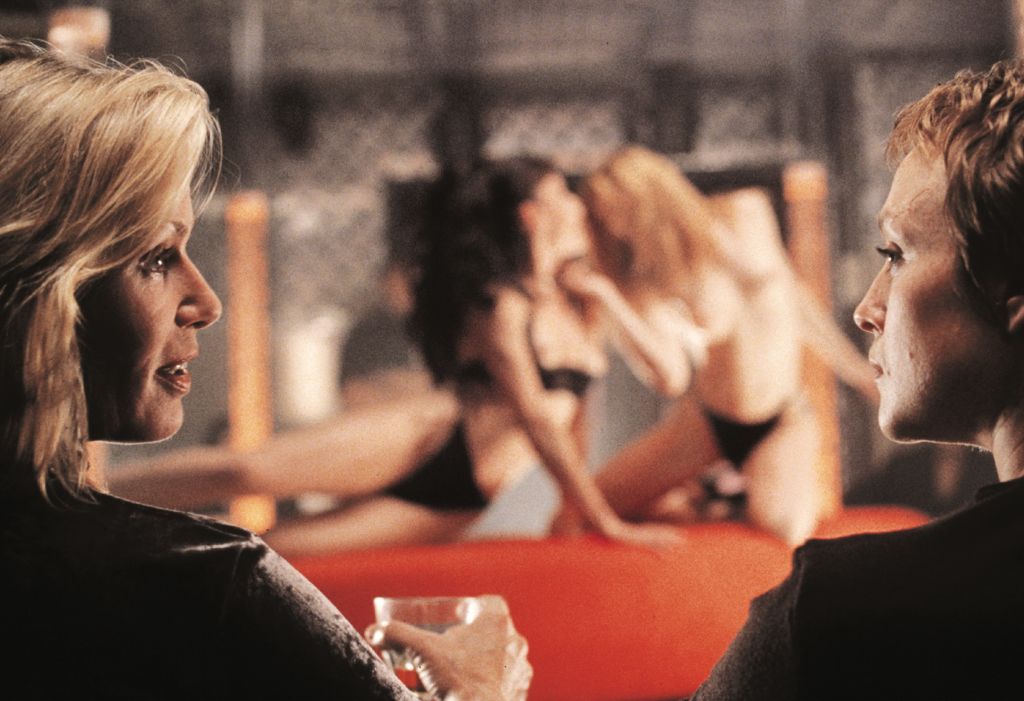
In fact, television seemingly remains the primary medium for LGBTQIA visibility, just as it was in the days of the Australian series Number 96 and The Box. TV’s role in bringing queer representations to larger audiences is best epitomised by the decision to turn Rachel Ward and Tony Krawitz’s 2014 sequel to Fred Schepisi’s The Devil’s Playground (1976) into a miniseries. Indeed, in the decade after the year 2000, fiction features with queer themes dropped off substantially, and these scant numbers primarily reflect those in which homosexuality was only a secondary element – such as Lantana (Ray Lawrence, 2001), Tom White (Alkinos Tsilimidos, 2004) and Last Train to Freo (Jeremy Sims, 2006). One might have expected Australian filmmakers to more accurately represent queer culture in light of changes in societal attitudes towards the LGBTQIA community. However, rather than more films with the Gen X mentality of casual sexuality – as seen in the scrappy university rom-com Love and Other Catastrophes (Emma-Kate Croghan, 1996) – gay issues seem to have become relegated to the arenas of short film, as in Saturn’s Return and Blow (Marie Craven, 2002); the occasional AIDS drama, like Walking on Water (Tony Ayres, 2002); and the musical camp of films like Moulin Rouge! (Baz Luhrmann, 2001).
At least, among that disappointing downward trend, documentaries like Sissy (Debbie Gittens, 2000), Nijinsky: The Diaries of Vaslav Nijinsky (Paul Cox, 2001), The Tasty Bust Reunion (Stephen MacLean, 2004), The Hidden History of Homosexual Australia (Con Anemogiannis, 2005), The Prodigal Son (Tony Radevski, 2006), Bastardy (Amiel Courtin-Wilson, 2008) and All the Way Through Evening (Rohan Spong, 2011) occasionally hit screens, albeit through extremely limited releases or on specialty television networks.
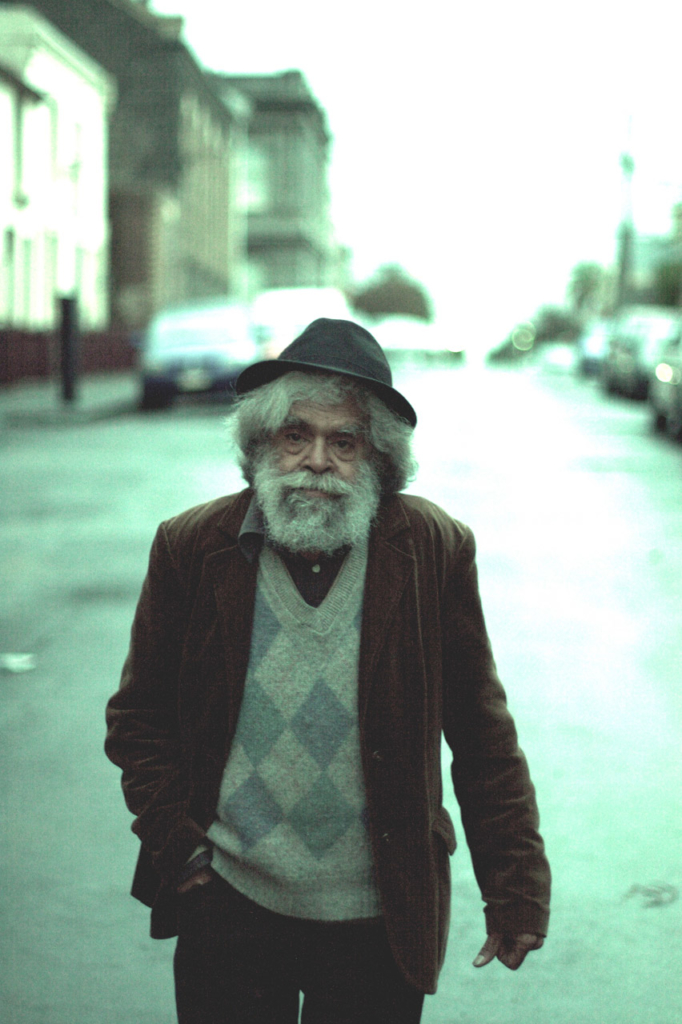
Coming out to the world: Film festivals
Perhaps ironically, the cultural watershed moment that was the release of Brokeback Mountain (Ang Lee, 2005) – touted as ‘Hollywood’s first gay love story’[8]David Leavitt, ‘Men in Love: Is Brokeback Mountain a Gay Film?’, Slate, 8 December 2005, <http://www.slate.com/articles/arts/culturebox/2005/12/men_in_love.html>, accessed 20 August 2015. – coincided with what can be considered the death of the indie queer cinema model. It was as though the relative level of mass acceptance that homosexuality had achieved obviated filmmakers’ need to challenge the system, with distributors then feeling that there was less money to be made. It’s certainly hard to picture a film as ferociously queer as Mysterious Skin (Gregg Araki, 2004) garnering as much popular appeal in 2015 as it did a decade ago. With the exception of something uniquely special like Weekend (Andrew Haigh, 2011), it is increasingly only through big stars and award-season prestige that films dealing with queer subject matter – Dallas Buyers Club (Jean-Marc Vallée, 2013), The Imitation Game (Morten Tyldum, 2014), The Danish Girl (Tom Hooper, 2015) and Carol (Todd Haynes, 2015) come to mind – are able to find any attention beyond speciality audiences, especially in Australia.
‘Festivals are still incredibly important for filmmakers to get their work viewed by larger public audiences … only around 3 per cent of the 172 films screened at the 2015 MQFF will receive further screenings outside of the film-festival circuit.’
– Lisa Daniel
It is during this time that queer film festivals have taken on the mantle to bring these niche films to audiences. ‘Distributors are notoriously risk-averse when it comes to selecting titles for their catalogues,’ says Lisa Daniel, who recently left her seventeen-year post as festival director of the Melbourne Queer Film Festival (MQFF), which in March celebrated its twenty-fifth year. ‘Queer-themed films in particular often get shunted to the bottom of the distribution/theatrical release pile.’ These days, queer film festivals are undeniably the first port of call for filmmakers hoping to entice speciality distributors like Wolfe Video, Strand Releasing and TLA Releasing. In Australia, there are major queer film festivals in Melbourne and Sydney, plus smaller ones in Brisbane, Perth, Adelaide, Cairns and Bendigo that run conjunctive to other queer cultural events. Additionally, there is a growing number of specialty festivals that work within even narrower corridors of the queer film landscape, and which don’t necessarily run annually. The most successful example of this is Tilde, a Melbourne-based trans and gender-diverse film festival, but there is also Dyke Drama, a lesbian-centric short-film festival based in Perth, and shOUT!, which travels to Canberra, Newcastle, Western Sydney, Coffs Harbour and the Gold Coast.

‘Festivals are still incredibly important for filmmakers to get their work viewed by larger public audiences,’ Daniel says, citing that ‘only around 3 per cent of the 172 films screened at the 2015 MQFF will receive further screenings outside of the film-festival circuit’. Likewise, Paul Struthers, director of the Mardi Gras Film Festival, has spoken of the power of queer cinema ‘to start discussion about issues of homophobia and transphobia that many are keen to sweep under the rug’.[9]Paul Struthers, ‘New Queer Cinema’, Metro Screen blog, 5 February 2015, <http://metroscreen.org.au/new-queer-cinema/>, accessed 20 August 2015.
In spite of the increase in numbers and popularity of queer film festivals, as well as the burgeoning overseas VOD market, the last ten years have been rough for the production of Australian films tackling LGBTQIA issues. It’s unsurprising to see an entire film-festival program without a single local queer feature on it – which is particularly disappointing, given how much more receptive audiences are to local products in a festival environment. Films like Tan Lines (Ed Aldridge, 2007), Newcastle (Dan Castle, 2008) and Monster Pies (Lee Galea, 2013) – all coming-of-age dramas featuring young gay men, two of which are about surfing – are hardly cause for enthusiasm.
The number of Australian titles at this year’s film-festival circuit have been encouraging, though. These have included All About E (Louise Wadley, 2015), Limited Partnership (Thomas G Miller, 2014) and Skin Deep (Jon Leahy, 2014), as well as Drown (Dean Francis, 2014), which won the 2015 MQFF’s audience-determined Best Feature Film award. Even more impressively received are Holding the Man (Neil Armfield, 2015), Women He’s Undressed (Gillian Armstrong, 2015) and Gayby Baby (Maya Newell, 2015), which all played at the Sydney Film Festival and have received theatrical releases – the last of these after being banned from screening in schools by the New South Wales government. The most significant Australian queer title to emerge in recent years, however, is 52 Tuesdays (Sophie Hyde, 2013), which is similarly experimental in technique to Boyhood (Richard Linklater, 2014). The film has elevated queer issues – in this case, the gender transition of a mother, James (Del Herbert-Jane), and the sexual curiosity this provokes in teenage daughter Billie (Tilda Cobham-Hervey) – to beautiful, world-class art, as evidenced by its strong critical reception as well as winning the Directing Award in the World Cinema – Dramatic category at the Sundance Film Festival, the Crystal Bear for Best Film in the Berlin Film Festival’s Generation 14plus strand, and other significant prizes from festivals in Toronto, Cork and Melbourne.
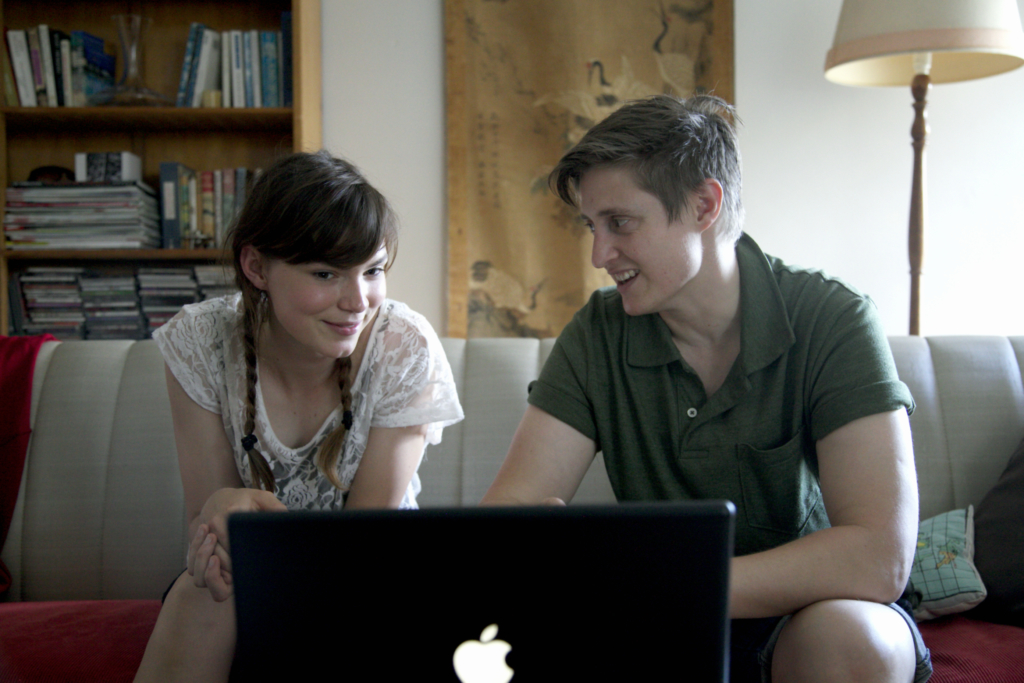
For all the success that The Adventures of Priscilla, Queen of the Desert has found, it was not a harbinger of things immediately to come. Hopefully, though, the global success of 52 Tuesdays and the rising number of queer titles two decades later are signs that Australian filmmakers are ready to take the leap with queer content and make it as cinematically compelling as many of our country’s other works. Priscilla’s arrival at the right place, at the right time, is attested to by its global recognition, as well as the fact that no other local queer film has enjoyed as much mainstream success. Thankfully, the future is looking brighter both here and internationally for queer cinema, as more voices and newer stories are being given the chance to be told. Besides, we don’t need another ‘cock in a frock on a rock’ when the first one has kept us happy for twenty-one years.
Endnotes
| 1 | Screen Australia, ‘Top 100 Australian Feature Films of All Time, Ranked by Total Reported Gross Australian Box Office as at February 2015’, <http://www.screenaustralia.gov.au/research/statistics/boxofficeaustraliatop100.aspx>, accessed 20 August 2015. |
|---|---|
| 2 | National Film and Sound Archive of Australia, ‘Priscilla: 20 Years Young’, <http://www.nfsa.gov.au/visit-us/exhibitions-presentations/Priscilla-20-years-young/>, accessed 20 August 2015. |
| 3 | Luke Buckmaster, ‘The Adventures of Priscilla, Queen of the Desert: Rewatching Classic Australian Films’, The Guardian, 9 May 2014, <http://www.theguardian.com/film/australia-culture-blog/2014/may/09/the-adventures-of-priscilla-queen-of-the-desert-rewatching-classic-australian-films>, accessed 20 August 2015. |
| 4 | Screen Australia, op. cit. |
| 5 | Kevin Thomas, ‘Movies: Collision with Life: Director Looks at What It Means to Be Greek and Australian, Gay and Conflicted’, Los Angeles Times, 2 September 1999, <http://articles.latimes.com/1999/sep/02/entertainment/ca-5854>, accessed 20 August 2015. |
| 6 | Kokkinos adapted Head On from the novel Loaded by Christos Tsiolkas, whose fingerprints would linger further in the Australian queer titles Saturn’s Return (Wenona Byrne, 2001) and Dead Europe (Tony Krawitz, 2012). |
| 7 | James Waites, ‘An Elegant Charm Was Her Best Material’, The Sydney Morning Herald, 22 August 2011, <http://www.smh.com.au/comment/obituaries/an-elegant-charm-was-her-best-material-20110821-1j4li.html>, accessed 20 August 2015. |
| 8 | David Leavitt, ‘Men in Love: Is Brokeback Mountain a Gay Film?’, Slate, 8 December 2005, <http://www.slate.com/articles/arts/culturebox/2005/12/men_in_love.html>, accessed 20 August 2015. |
| 9 | Paul Struthers, ‘New Queer Cinema’, Metro Screen blog, 5 February 2015, <http://metroscreen.org.au/new-queer-cinema/>, accessed 20 August 2015. |
